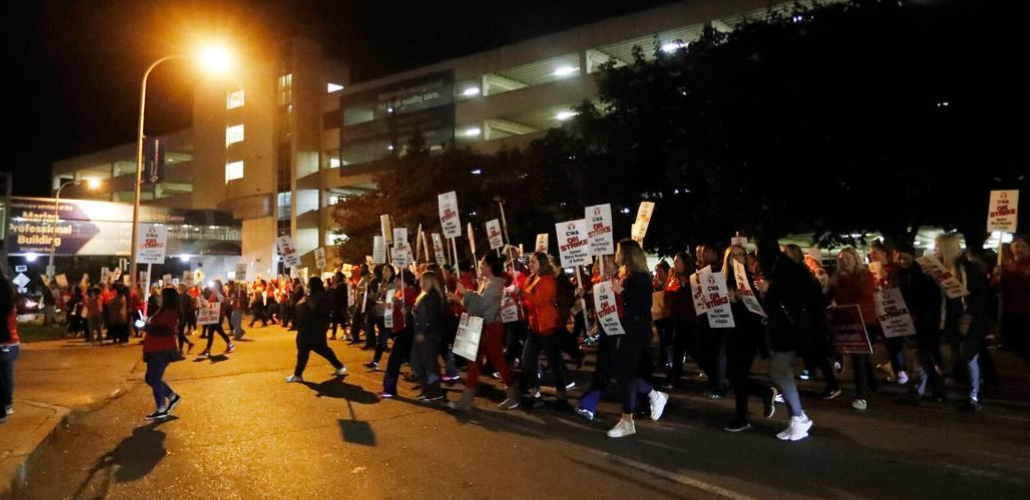Two Thousand Hospital Workers Strike in Buffalo

Strikers at Mercy Health kicked off their strike at dawn on October 1. Their top demand is better staffing—and they argue wages must increase to retain enough staff. The pandemic has intensified the problem of hospital understaffing nationwide. Photo: Patrick Weisansal
Two thousand nurses, clerical workers, technologists, and service workers have walked out of Mercy Health in Buffalo, New York, in an open-ended strike over the hiring and retention of workers throughout the hospital.
At 6 a.m. on October 1, the sky just starting to lighten, an already full picket line cheered the night shift workers flooding out the front doors to take a stand against Catholic Health System (CHS), which owns Mercy Hospital of Buffalo and two other hospitals in the area.
A livestream video on Facebook catches people hugging their colleagues and friends, cheering, sometimes shaking their heads in seeming disbelief—maybe at their own strength. There’s a steady stream of car horns honking solidarity in the background.
The strikers’ main demand is an enforceable commitment to safe and fair staffing. They are also battling the company’s attempt to convert their pension into a 401(k) and their health insurance to a high-deductible plan.
Better wages are another key demand—and closely linked to attracting and retaining enough staff in a competitive market. Entry-level respiratory therapists, for instance, are making $3 an hour more at another chain in town, Kaleida Health.
Jennifer Thoms, a dietary shift leader, has seen dramatic turnover in her 13 years at Mercy. Sometimes there are only three people trying to get meals to 280 patients. “It’s exhausting,” she said. “I just hope they bring the workers up to a better wage so we can get people in and they stay there.”
When the contract expired in the middle of last year—with Covid still rampant, surgeries getting canceled, and people avoiding hospitals—CHS claimed it had been decimated financially by the pandemic. So the staff agreed to an extension, and to a raise of just a half a percent for the year.
But news soon broke that CHS had acquired land to build another hospital. “On the last two contracts we took concessions and they’re building this multimillion-dollar building,” said Shannon Sherman, a respiratory therapist. “Now they say they don’t have the money. We have employees who don’t even make $15 to clean and sanitize infectious rooms. They would rather work at McDonald’s.”
ONE OUT OF THREE
The Mercy strikers are members of Communications Workers (CWA) Local 1133, which also represents the 400 workers at another nearby CHS facility: Mercy Hospital in Kenmore. The 250 workers at Sisters of Charity Hospital, St. Joseph’s campus, are represented by CWA Local 1168.
Recognizing the potential strength of bargaining together against the chain, Locals 1133 and 1168 sought to coordinate the expiration dates of their contracts and force a master agreement in the last round of negotiations in 2019.
This meant delaying bargaining the St. Joseph’s contract until 18 months after it expired. The hospital filed charges against the union for this tactic, but members were ready to dig in their heels on the issue, after an organizing and education campaign on the power it would give them if they could get the contracts all lined up.

SUPPORT LABOR NOTES
BECOME A MONTHLY DONOR
Give $10 a month or more and get our "Fight the Boss, Build the Union" T-shirt.
Ultimately the unions got their coordinated bargaining—and in exchange, CWA District 1 leaders agreed to a no-strike clause for two of the three hospitals this time around.
That’s why only the largest hospital, Mercy, is on strike now—but for an agreement that will also cover members of both locals at the other two locations. The bargaining includes leaders from both locals and all three hospitals, negotiating for both the master contract and their local agreements.
Bargaining together allows the three units to fight back jointly against the concessions CHS has proposed, and to fight for standard wage rates across the facilities.
One example of the current disparity: when Sherman started her new career at Kenmore as a respiratory therapist—a job that requires an additional degree—she took a pay cut from her previous job as a secretary at Mercy. Things have improved slightly since then, but Sherman believes standard pay rates would stop some of the staff churn.
Non-striking members at CHS hospitals are raising money and running food drives for Mercy workers. They’re leafleting at Buffalo Bills football games, local theaters, and a popular Gay Bingo fundraiser. Staff mobilizers of Local 1168 are on loan to help Local 1133 organize a successful strike.
COVID BREAKING POINT
Workers at all three hospitals are fatigued from being on the frontlines of the pandemic—particularly at St. Joseph’s, which was designated as the region’s sole Covid-only hospital at the peak of New York’s crisis in March 2020. It’s still the primary Covid facility in later surges, though it has admitted some other patients since last summer.
The pandemic is responsible for people leaving hospital jobs in droves, exacerbating a decades-long plummeting of staffing to dangerous levels nationwide. Even before Covid, workers emphasize, the situation was dire.
In previous contracts, the union won the creation of labor-management committees on staffing and workload. Sherman served on those committees, and came away frustrated: “They make promises and put minimal effort forward without ever really intending to fix it.”
Bob Scime, a longtime staff mobilizer for CWA 1133, believes the disrespect from management during the pandemic is what pushed has workers over the edge to strike.
“It’s like Vietnam vets when they came home and didn’t feel respected,” he said. “People died, and the lack of compassion and the disrespect is overwhelming.”






